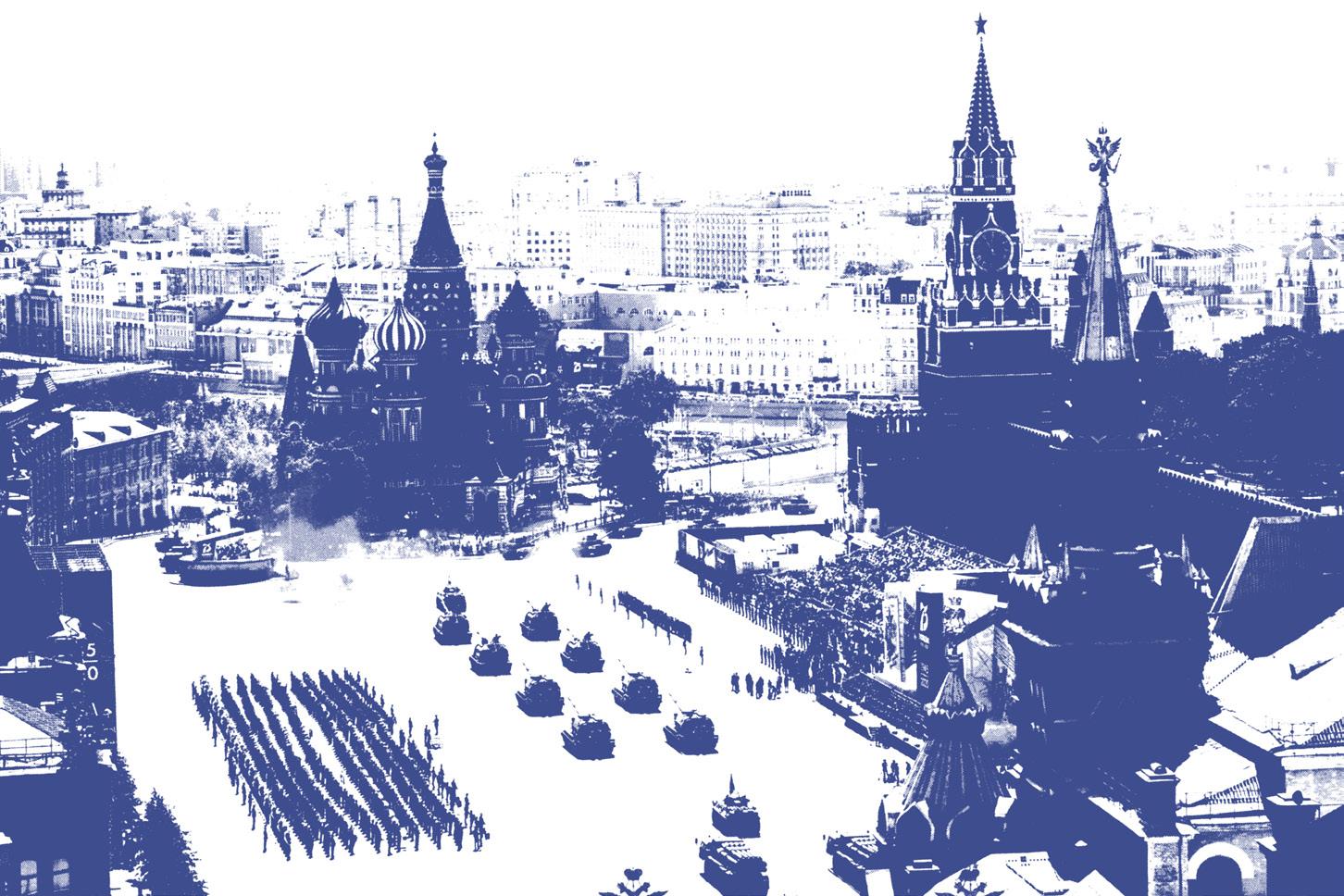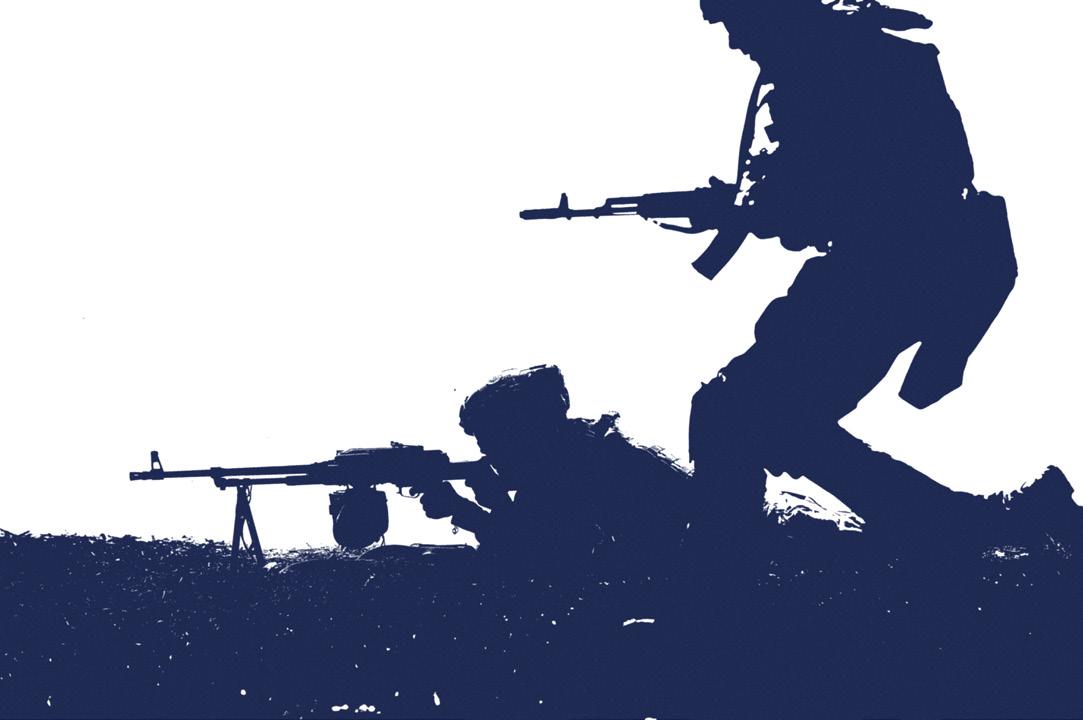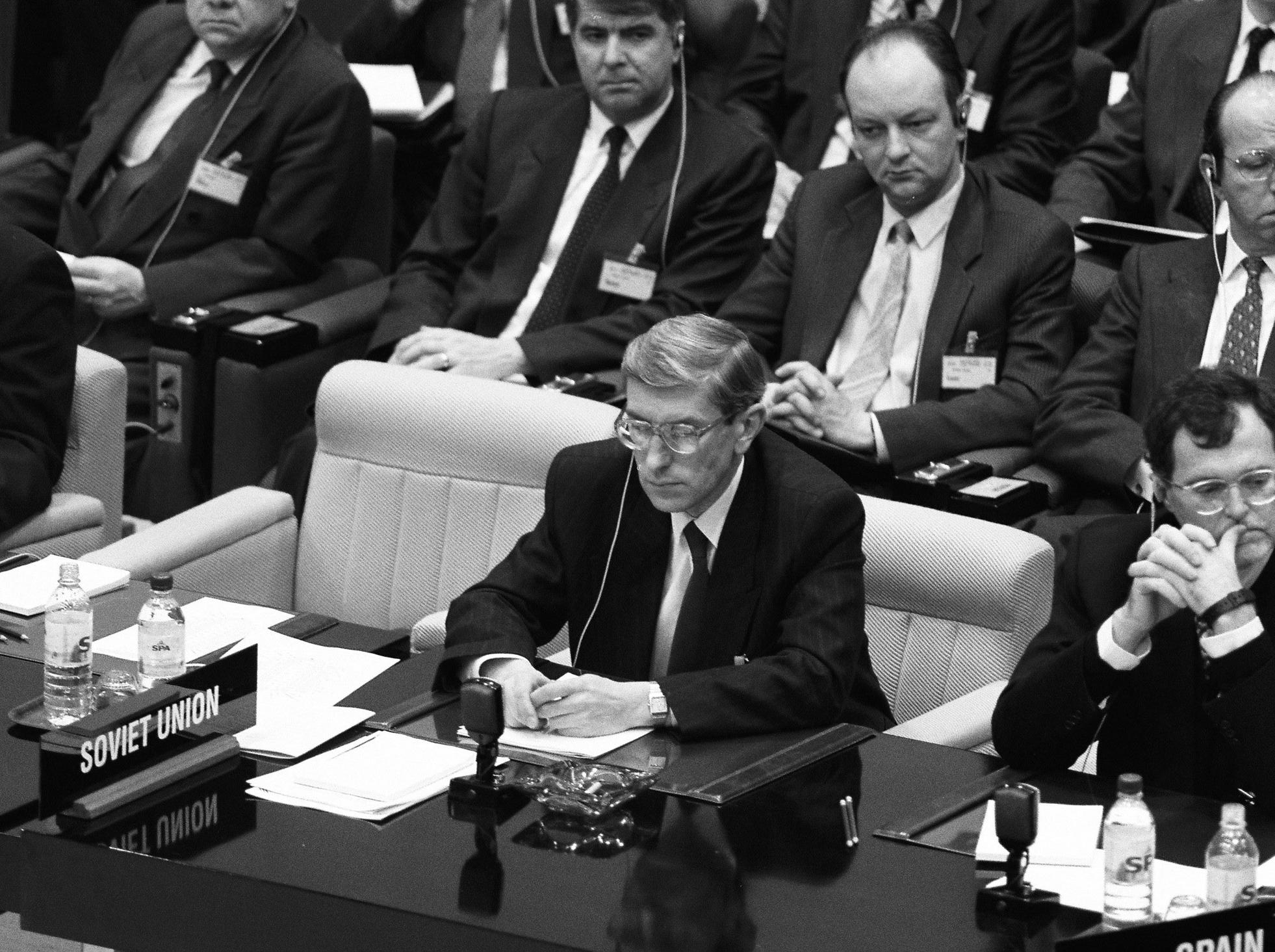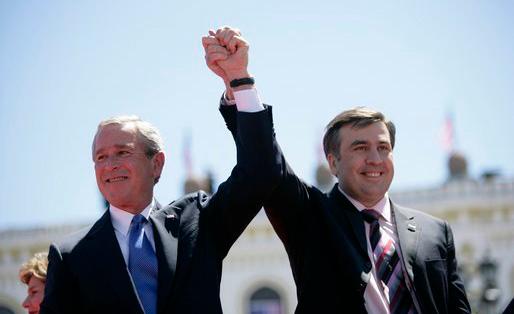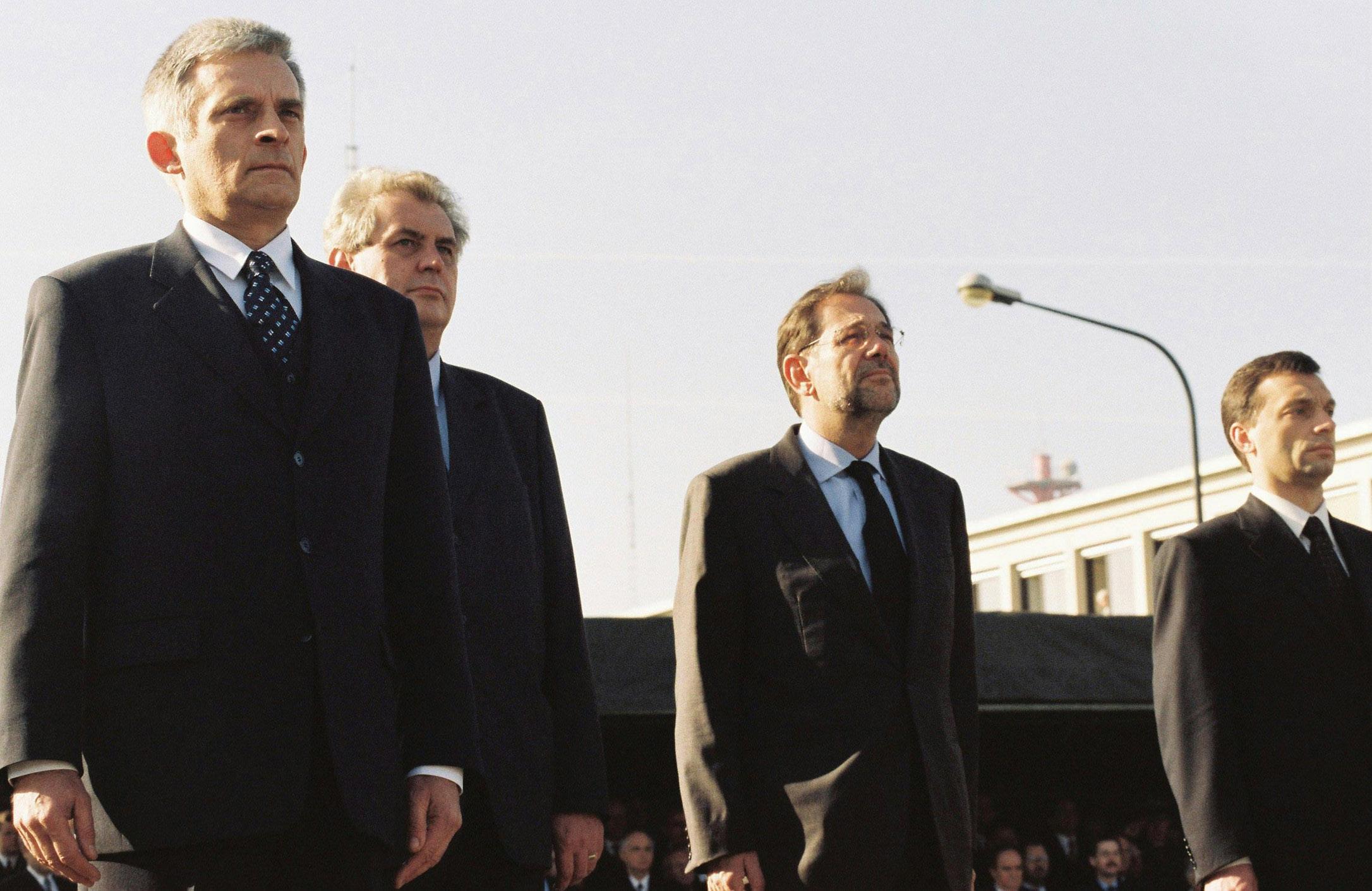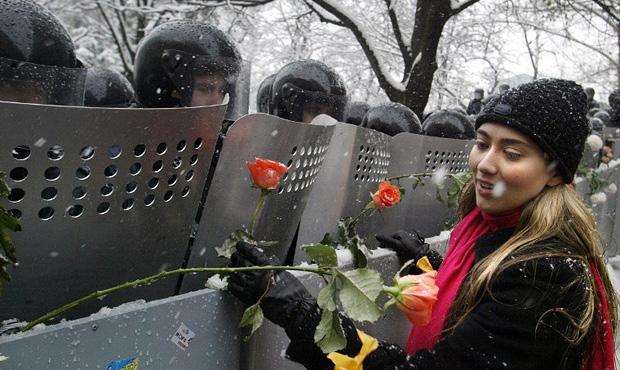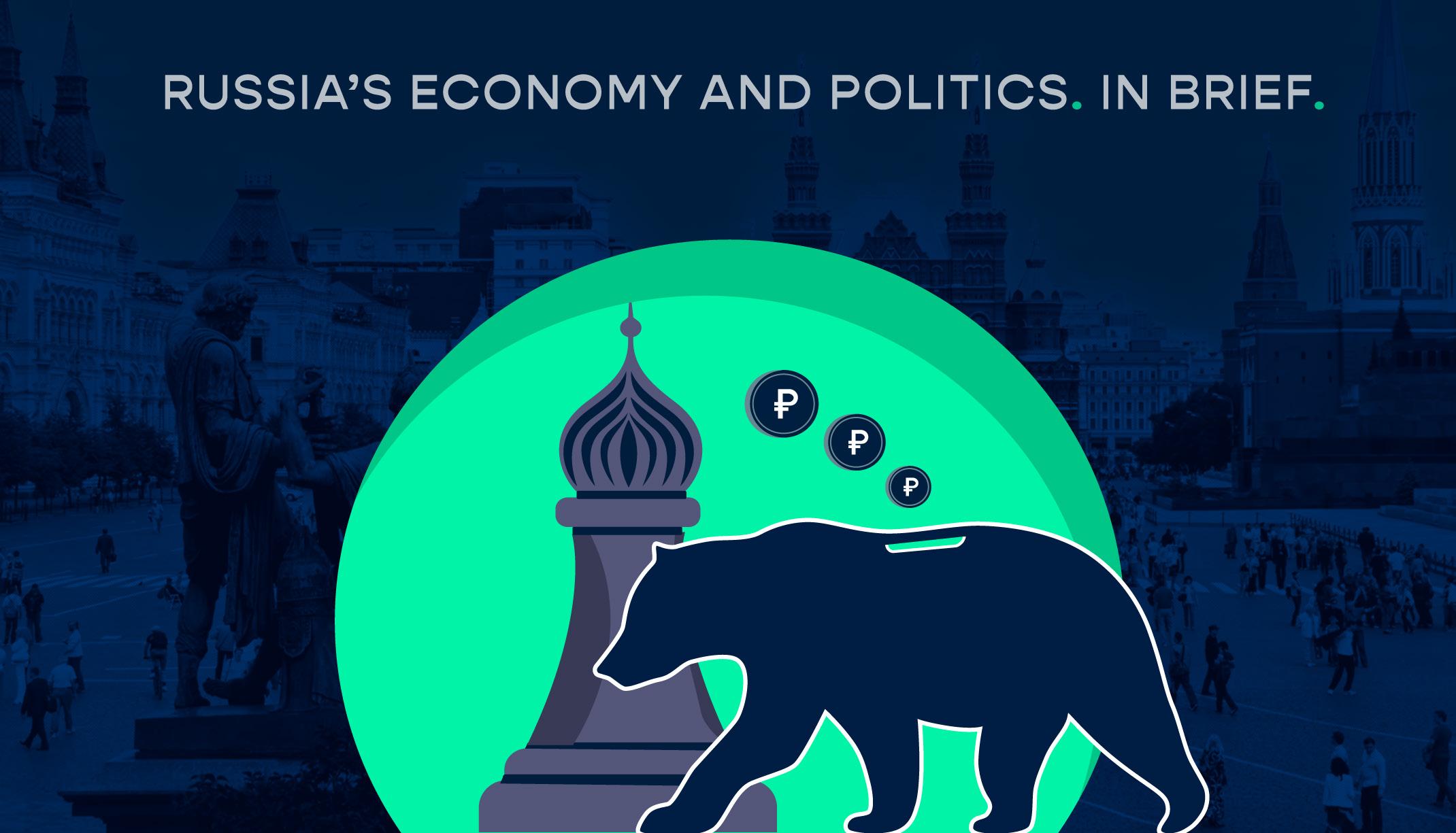Understanding Russian Threat Perceptions
Understanding how Russians identify their role in the international order, I will analyze the threats to Russia. This analysis will not separate threats for Russia and Putin’s regime as they are fully united and create one element. According to Elias Götz and Jørgen Staun, whose article explains the strategic culture concept, Russian elites fear the state’s vulnerability to external attack. They explain this issue using four consistent narratives:
1. Russia has a huge borderline, and it is difficult to protect the state everywhere simultaneously.
2. Russia should have buffer zones and strategic depth. This narrative is a result of many invasions throughout history. For Russians, it is important to control key areas and not to allow other great powers to control them. It is essential to have buffer zones in its spheres of influence.24
3. The West comprises the main threat to Russia. This narrative has resulted from history—both Napoleon and Hitler invaded and wanted to occupy Russia. During the Cold War, the main
adversaries of the Soviet Union were the United States and NATO, reinforcing the idea of a Western threat. In this case, Russian leaders after the collapse of the Soviet Union chose NATO as a potential threat. In all strategic documents, NATO enlargement was presented as a possible threat. After the annexation of Crimea, official statements were more aggressive and directly accused the West of aggressive actions.25
4. Russian leaders unite external and internal threats. For them, “color revolutions” are not popular uprisings but Western plots conducted against neighboring regimes loyal to Russia but weak, and put pro-West politicians in their places.26 Russian leaders have strongly believed that the West deliberately toppled pro-Russian governments and interfered in Russian spheres of influence. They feared the final result would be protests and revolution in Russia.27
Despite the Kremlin’s fears, before February 24, 2022, there was no threat of a color revolution in Russia. Then and now, there is no opposition movement in the state which can overthrow President Vladimir Putin’s regime. Analyzing Russian identity and how the Russian government views its threats suggests looking at links between them. Russian officials believe that NATO threatens their idea of being a great power with spheres of influence. The role of Ukraine is another common theme.
As mentioned, the idea of an aggressive West that wanted to defeat and destroy Russia developed in the 19th century after the total collapse of the Russian Armed Forces in the Crimean War. Later, this idea was redeveloped and adjusted to the current political situation in Russia. George Kennan, in his work The Sources of Soviet Conduct, wrote that the main aim of the Communists who came into power after the Russian empire had been destroyed was to secure that power. To do so, they focused first on
internal enemies and then on external ones. For the Russian Communists, the external world was aggressive, so they had to change the existing international order.28 These theses have much in common with current Russian threat perceptions. According to Soviet decision-makers, there was a connection between internal and external enemies: Internal opposition could exist only as supporters of—and supported by— hostile capitalism. They were able to portray their internal enemies in such a way so long as they acknowledged the presence of capitalism inside the country. After officially destroying the enemy’s ideology within the Soviet Union, they needed to maintain the idea of the external enemy to justify the totalitarian regime and repressions inside the state. At that time, one more famous Russian narrative was created—the “besieged fortress.”29
American scholar Zbigniew Brzezinski wrote in 1994 that, after the collapse of the Soviet Union, the White House changed the grand strategy from containment of Soviet enlargement to deep cooperation with democratic Russia. The main aim of such cooperation was to provide full support for Russian President Boris Yeltsin. Russia received huge financial support as well as political and international recognition. The United States even acknowledged the right of Russia to interfere in neighboring states. According to the US government, this was acceptable as the cost of ending the long period of confrontation with the Soviet Union. However, Russian leaders did not share the same optimism in bilateral cooperation. Twothirds of the Russian population shared the idea that the collapse of the Soviet Union was a tragic mistake that should be corrected.
The Russian imperial impulse was stronger than the United States wanted to recognize. Brzezinski argued in 1994 that Russian desire to control post-Soviet countries would cause future tensions with NATO.30 These predictions came true. Russia was fully opposed to the idea of NATO enlargement to
the east. In June 1995, the Russian Council on Foreign and Defense Policy issued a report: “Russia and NATO.” It stated that NATO expansion could lead to the “first serious crisis in relations between Russia and the West since the end of the Cold War.” Later, Russia would claim that the West used its weakness against it. In the National Security Concept of the Russian Federation 1997 the future enlargement of NATO to the east was defined as unacceptable because it represented a threat to Russian national security.31 Through such statements, Russia started to redefine its main adversary. This period of Russian strategic culture ended when Putin came to power in 1999. Having inherited a state that now had the West as its main adversary, Putin attempted to meet the threat that the adversary allegedly posed.
Having inherited a state that now had the West as its main adversary, Putin attempted to meet the threat that the adversary allegedly posed.
After the dissolution of the Soviet Union, Putin and other elites chose a sense of grievance against Europe and the United States, or the so-called Collective West. They did this because of their worldview and experience during the Cold War. Putin and his circle are representatives of the “greatest generation” of the Soviet Union. They grew up and achieved the highest steps in their careers when the state was at the highest point of power and controlled a huge European empire. They served in the Secret Service and armed forces, so they belonged to a special class. This allowed them to receive benefits affordable to very few people. At that time, the West was an adversary for them and wanted to destroy the Soviet Union with propaganda and promote Western values.
After the end of the Cold War, for many of them, the West continued to be the enemy.32
This second stage of Russian strategic culture is characterized by step-to-step confrontation with the West. Russia presents itself as a victim of an unjust international order. The Kremlin accused the United States of a desire to build and maintain a unipolar world. Additionally, NATO is presented as the main destructive element in the European security architecture, requiring Russia to protect itself. Since the 2000 National Security Concept of the Russian Federation, NATO has been treated as the main threat.33 However, after September 11, 2001, Putin hoped to build stronger relations with the United States based on fighting terrorism. Later he expressed interest in joining NATO and NATO wanted to give Russia a unique status almost equal to that of a member-state. After the color revolutions in Georgia and Ukraine in 2003 to 2004 and the great desire of the United States to expand the Alliance,
relations started to degrade. Following the NATO Summit in Bucharest in 2008, when the Alliance declared that Georgia and Ukraine would someday become NATO members, Russia officially stated that it would do everything possible to prevent them from joining. “We will do all we can to prevent Ukraine’s and Georgia’s accession into NATO and to avoid an inevitable serious exacerbation of our relations with both the Alliance and our neighbors,” Russian Foreign Minister Sergey Lavrov told reporters.34 Seventy-seven percent of the Russian population supported such a policy and voted that Ukraine in NATO would pose a threat to national Russian security interests.35
The Russia-Georgia War, the refusal of Western countries to sign security agreements, and the revolutions in Arab states increased the threat perception in Russia. The next pieces of evidence in Putin’s eyes were the protests in Russia after the election in 2011. He claimed that protesters
US President George W. Bush and Georgian President Mikheil Saakashvili in Tbilisi, May 2005. (Eric Draper/White House/Wikimedia Commons)
were supported and funded by the United States.36 In 2014, when former Ukrainian President Viktor Yanukovych fled to Russia after the Revolution of Dignity, Putin blamed the United States more aggressively. After Russia’s illegal annexation of Crimea, Putin amped up his rhetoric about the West’s alleged aggression. The pieces of evidence were economic sanctions, the nonrecognition of Crimea as part of Russia, and NATO’s new strategy. NATO decided to posture four battalions in Poland and the Baltic states in a rotation base. Also, the number of military exercises conducted by NATO increased. The Alliance presented such actions as a deterrence measure. Russia saw them as a confrontation.37
In Russia’s view, NATO’s enlargement was less a military threat than an unjust interference in Russia’s sphere of influence.
In the Russian Military Doctrine 2014, Russia recognized the buildup of NATO’s power potential and its expansion as one of the main external military risks that could lead to military threats. Another risk related to spheres of influence was the establishment of pro-Western regimes whose policies threatened the interests of the Russian Federation in the states contiguous with it, including by overthrowing legitimate state administration bodies. This bullet directly addressed political changes in Ukraine.38 The National Security Strategy of 2015 continues this rhetoric, stating in Article 12 that Russia’s independent policy was opposed by the United States and its allies, who wanted to regain dominance in the world and were attempting to do so using all instruments of power except the military. This document defines the buildup of the military potential
of NATO and its expansion as a threat to Russian national security (Article 15).39 Article 61 of the Foreign Policy Concept 2016 said that the geopolitical expansion of NATO and the refusal of Western countries to create a common European security cooperation framework created a crisis in the relations between Russia and the West. Also, this document addresses the spread of Western values seen as dangerous for Russian society.40 All these documents demonstrate Russian leaders’ perception of the Western threat.
When the coronavirus pandemic started in 2019, Russian discourse became less aggressive toward the West and was oriented on overcoming the pandemic. However, the National Security Strategy in 2021 continued to promote anti-Western narratives and presented Western countries as the enemy. In this document, countries were labeled as unfriendly states that tried to use socioeconomic problems in the Russian Federation to destroy its internal unity, instigate and radicalize a protest movement, support marginal groups, and divide Russian society.41 In doing so, the Kremlin claimed that protests inside Russia could only be conducted by the anti-Russian population and funded by the West. This echoed the Soviet Union’s persistent claims that opposition was funded by capitalist states. Putin repeated several times in two addresses on February 21 and 24, 2022 that the West was a threat to Russia. In those circumstances, Russia could not allow the further expansion of NATO. The Kremlin even justified the commencement of the invasion using Article 51 of the UN Charter as a right of preemptive self-defense against military threats.42
Summarizing Russia’s threat perceptions requires paying key attention to the West because the role of the West is interconnected with other Russian threats. In Russia’s view, NATO’s enlargement was less a military threat than an unjust interference in Russia’s sphere of influence. Putin strongly believes that all color
revolutions were conducted to overthrow loyal Russian governments, with the final goal of overthrowing Putin’s regime in Russia. Russia is an autocratic regime, which requires an external enemy for justification of the repressions inside the state. The same happened when it was the Soviet Union or the Russian Empire. Finally, Russian leaders and the population believed that Russia was a unique civilization that should be protected and was constantly under threat of invasion, usually from the West. Having outlined Russia’s threat perception, I will continue with the Russian attitude toward using force.
Understanding the Russian Attitude Toward Using Force
The last feature of Russian strategic culture I analyze is its attitude toward the use of force in international disputes. This element deserves to be analyzed separately because the use of force plays a significant role in Russian strategic thinking. It is important to understand when and why Russia prefers military force over negotiations. Understanding this provides insight into why Russia launched a full-scale invasion against Ukraine in 2022.
Anna Antczak writes that militarism is a separate element of Russian strategic culture; it could be described as a special role of war and the armed forces in building national identity.43 Wiltenburg points out that Russia uses its military force to assert its power as a state. Russia’s willingness to use the armed forces is connected to presenting itself as a great power. He highlights three cases where Russia is likely to use military force. First is when the probability of external conflict rises, as it can decrease national security. Second is when Russia takes on responsibility for
its sphere of influence and provides military defense. Third is when Russia can use the violation of the Russian diaspora’s rights in its neighboring countries or “near abroad” as a reason. For Russia, the use of military force is a legitimate tool of foreign policy. Even more, Russia believes that only great powers have the right to act in a such way.44 Evan Kerrane develops this idea more: He writes that Russian militarism creates a unique element of its strategic culture. Russian militarism frames how the Kremlin treats the world.45 Understanding Russia’s apparently brutal behavior requires examining the historical evolution of the Russian approach to using force.
Evolution
The attitude of Russian leaders toward using force is well described by Russian Emperor Alexander III who said that Russia had just two allies, the army and the navy. Putin repeated this quote during one of his public meetings.46 Since then, military power has played a crucial role in Russia’s strategic culture because of Russia’s enormous human resources. Soldiers were always available and could be easily replaced. Such a situation provided Russia with a very cheap tool for resolving international disputes.47 Moreover, Russia has grown significantly since the 16th century through conquering territories. Such foreign policy required a strong armed force. Finally, to conduct such brutal actions required an autocratic form of government. Russian leaders have long accepted and promoted these attitudes toward the use of force against other states and Russia’s own population.
During the period of the Soviet Union, the state participated in enormous conflicts, the largest of which was World War II. But before they fought against each other, the Soviet Union and Nazi Germany signed the MolotovRibbentrop Pact, a secret protocol. In doing so, they divided Europe between them. After signing the pact, Nazi Germany invaded
Vladimir Putin with President Boris Yeltsin on 31 December 1999, when Yeltsin announced his resignation. (Kremlin.ru/Wikimedia Commons)
Polish Prime Minister Jerzy Buzek (left) watches his country’s flag rising at NATO Headquarters alongside (left-to-right) Czech Prime Minister Milos Zeman, NATO Secretary General Javier Solana and Hungarian Prime Minister Viktor Orban. (NATO)
Poland, and Soviet troops later joined them and occupied the eastern part of that country. Later, the Soviet Union occupied the three Baltic States and launched a war against Finland. These actions show how Soviet leaders used force to achieve their strategic objectives. After World War II, the so-called Cold War began between the United States, the Soviet Union, and their allies.
Putin’s rule has continued the long pattern of using force to resolve disputes and advance Russian interests.
Putin’s rule has continued the long pattern of using force to resolve disputes and advance Russian interests. When Putin came to power, he pledged a return to stability. His inaugural ceremony highlighted the main objective of the future regime—Russia would be a centralized state with strong armed forces.48
Putin, as a former KGB officer, clearly understood what a huge role military force played in presenting Russia as a great power. After the NATO operation in Kosovo, Russia was presented as a weakened state that could not protect its interest in this area. The Kosovo campaign convinced Putin that the West wanted to destroy Russia. He saw building powerful Russian armed forces as the only way to prevent it. On January 10 and April 21, 2000, Putin signed Russia’s new National Security Concept and Military Doctrine. The concept highlighted that military force remained a substantial aspect of international relations. In the third chapter, it states: “At present, this can be seen in the critically low level of operational and military training in the Armed Forces of the Russian Federation . . . and in the impermissible drop in the equipment of the forces with modern armaments and military and special hardware this leads to a weakening of the
military security of the Russian Federation as a whole.”49 Russia’s Military Doctrine was developed in the same manner and promoted the need for strong armed forces.50 So, in 2001 the rebuilding of Russian armed forces started. The main aim of the reforms was to establish a military force that could impose fear inside Russian spheres of influence. The Kremlin understood that Russia was not capable of creating a block or union similar to NATO or the European Union. So, the only possible tool for influence was fear. This was the point where militarism in Russia became stronger.51
The first alarming signal was Putin’s speech at the 2007 Munich Conference on Security Policy. Putin directly blamed the United States for using military force in the international area. He blamed NATO and the European Union for using force against other countries without a UN Security Council resolution. Putin also said that Russia would not use armed forces without UN approval. However, he mentioned Russia’s right to self-defense, which would be used as a main argument for aggression against Ukraine in 2022.52
In 2008, after the Bucharest Summit where NATO announced that Ukraine and Georgia would be members of the Alliance, Lavrov told the Echo of Moscow radio station that “[w]e will do everything possible to prevent the accession of Ukraine and Georgia to NATO.” And Russia did—it sent troops to defeat Georgia four months after the NATO announcement. Another reason for Russia’s invasion of Georgia was to illustrate that Russia was powerful enough to counter the West. Russia wanted Western countries to conclude that they were incapable of contesting Russian power inside its spheres of influence.53 After a fast, five-day successful war and a weak response from the West, Russian leaders were convinced that they could achieve more by using brutal military force. As a result, Russia continued the modernization of its armed forces so it could conduct successful military operations abroad by using hybrid methods.54
Russia, led by Putin, started a huge modernization of the armed forces to create a powerful military force that could help achieve strategic goals—regaining its hegemonic position in the region and, if possible, the world. After increasing Russia’s military power, Putin started to accuse the West of launching armed conflicts and violating the UN Charter. In doing so, Russia began to create the legal basis for further conflicts. For the Kremlin, the war against Georgia proved the superiority of military power over negotiations. It also showed that Russia would not be punished if it did the same in the future. With this knowledge, Putin seized Crimea in 2014 and, eight years later, started the biggest war in Europe since the end of World War II.
Why Ukraine?
Russian strategic culture consists of three main beliefs. First, Russian leaders and society believe that Russia is a great power. Second, this great power status is strongly connected with the right to have spheres of interest, especially in post-Soviet countries. Third, Russians present themselves as defenders of traditional values and a unique civilization. These beliefs led the Kremlin to conclude that the Western world, led by the United States, was its main adversary because it pushed back against Russia’s attempt to control the countries of its near abroad. The West is also seen as a cultural adversary because its values and style of life are more popular in the world than Russia’s. To oppose these alleged threats, Russia needs strong armed forces, and Russian leaders have not hesitated to utilize them during history. Spheres of influence also have another value for Russia as buffer zones. In this way, Ukraine plays a special role for Russia. Götz writes that there are two reasons for this. First, several invasions from the West came through Ukraine and Belarus. Second,
the Kyivan Rus is the motherland of Russian civilization.55 Putin and his circle clearly understood that the West would not attack Russia. Western leaders have demonstrated a desire to cooperate with Russia even after the 2014 Crimean occupation. They also clearly stated that NATO troops would not fight in Ukraine. For Russia, the West is an ideological enemy, and that alone justifies internal repression since Kremlin leaders claim the West colludes with groups inside Russia to destabilize it. Ukraine’s importance is linked to Russia’s status as a great power. Brzezinski wrote in late 1994 that Ukrainian independence was seen in Moscow as wrong and a threat to Russia’s global power status.56
For Russia, the West is an ideological enemy, and that alone justifies internal repression since Kremlin leaders claim the West colludes with groups inside Russia to destabilize it.
Ukraine is the biggest European country and is rich in natural resources. Its capital, Kyiv, has long-held ideological meaning for Russia. It was where the population of the Kyivan Rus was consecrated by Volodymyr the Great in 988. In his article about the unity of Russians and Ukrainians, Putin wrote that these two nations and Belarusians spoke one language (Old Russian), had economic relations, and one religion: the Orthodox faith. Then he continued with pseudo-historical facts about Ukraine. One sentence said, “Modern Ukraine is entirely the product of the Soviet era.”57 These words explain how Putin understands Ukraine. Huge Ukrainian territories were part of the Russian empire, several of the main
battles of World War II occurred in Ukraine, and many important factories and plants were located in Ukraine during the Soviet period. These are only a few reasons why Russians resist the idea of Ukrainian independence.58
The tensions between Ukraine and Russia appeared just after they received independence. In 1991, before the CIS was created, Yeltsin wanted to retake Ukraine, but he did not have enough power to do so. The only solution was to allow Ukraine to become independent and engage in revanchism.59 There were tensions between the two countries during the 1990s, but Russia did not dare to confront them directly. The issues with Crimea and the Black Sea Fleet were among the main triggers in Russian foreign policy. Russian leaders officially stated that Crimea is Russian land, and no one would take the Black Sea Fleet away. After a series of events, Russia and Ukraine signed a Friendship Treaty in 1997. This document was the highest point in their cooperation. After Putin came into power in 2000, their
relationship went in another direction.60
At the beginning of his rule, Putin did not oppose Ukraine’s decision to join NATO. In 2002, he said after the Prague Summit that Russia’s interests were not affected by good relations of Ukraine with NATO. Six years later, he spoke about Ukraine’s membership as an unacceptable thing.61 The beginning of the 21st century saw a parade of color revolutions, as Russian leaders prefer to call them. The Ukrainian Orange Revolution in 2004 was evidence that Ukrainian society did not want to be part of the Russian world and shared Western values. For Russians, that revolution had a different meaning—the West orchestrated the protest to overthrow a government loyal to Russia in its sphere of influence. Russia’s policymakers and political analysts claimed that the United States used democratization to undermine Russia’s international status and claimed that this represented a direct threat.62 Considering the still-incomplete modernization of the armed forces, Putin used other tools to control the
A protester in Kyiv inserts roses into riot police shields during Ukraine’s Orange Revolution. (Wikimedia Commons/Ukraine Revolution Blog)
Crowds gathered in Kyiv’s Maidan Square, February 2014. (Wikimedia Commons)
Ukrainian pro-Western government. These were gas blackmail, trade wars, and proRussian politicians who stoked fears of a NATO invasion. Unfortunately for Ukrainian society, Putin achieved his goals and managed to keep Ukraine under Russian influence.
The 2013-2014
Revolution
of Dignity, when Ukrainian society opposed the Ukrainian state’s turn toward Russia, was a volcanic eruption.
The main event that caused Putin to conclude that Ukraine was moving out of Russia’s orbit was not the 2008 Bucharest Summit, rather it was the Revolution of Dignity from 2013 to 2014. Putin was confident that, after 2008, pro-Russian candidates would take the presidential post in Ukraine. At that time, the support rate of pro-Western President Viktor Yushchenko was less than 10 percent. In October 2008, 93 percent of Ukrainians were dissatisfied with both the political and economic situation in their country.63 On the other hand, the Revolution of Dignity, when Ukrainian society opposed the Ukrainian state’s turn toward Russia, was a volcanic eruption. At Yanukovych’s request, Putin helped the former Ukrainian president escape to Russia.64 For Russia, that meant that Ukrainians wanted to side with the West. The Kremlin saw this as unacceptable because it could undermine the internal and external prestige of the Russian government and provide an example for the Russian opposition since it came when memories of the 2012 protests in Russia were still fresh. Finally, it threatened the main pillar of Russian foreign policy—the renovation of the former empire.
Among the reasons Ukraine is important for Russia is its geographic position. Russian elites and the population have shared common ideas about Ukrainian independence and its pro-western direction as well as unity between the two nations. In the history and evolution of cooperation between Russia and Ukraine, tensions and wars were not uncommon. Finally, the Russian attitude toward using force justified the occupation of Crimea in 2014.
Later that year, Russia launched a proxy war in Eastern Ukraine and used its armed forces to interfere in Ukraine. After 2015, when Ukraine signed the Minsk Agreement, Russia continued to pressure Ukraine using economic and diplomatic instruments. The Kremlin interpreted the 2019 election of President Vladimir Zelensky as a signal that it could control and manipulate Ukraine’s leaders. Zelensky’s main promise during the election campaign was to stop the conflict. For Putin, he was a comedian and not a serious opponent. After the withdrawal of troops in Zolote in November 2019, the two presidents met face to face in Normandy Format Summit in December.65
The two countries became closer; however, it did not last. Ukrainian policy became proWestern and anti-Russian. In 2020, NATO granted Ukraine Enhanced Opportunity Partner status. This was a signal that Ukrainian policymakers had not given up on the idea of joining the Alliance. Also, Zelensky started to work against pro-Russian oligarchs in Ukraine by blocking their TV channels. Viktor Medvedchuk, the most famous of them, was a godfather of Putin’s daughter. For Putin, this meant a new step in escalation.
Russia conducted a large military exercise, Zapad-2020, as a rehearsal for a possible invasion. In 2021, Russia deployed up to 100,000 troops near the Ukrainian border. The Kremlin began to believe that the West had created an anti-Russian Ukraine. These actions were seen as a threat to Russian
ideological and strategic objectives to control Ukraine and also as a threat from the West. Putin repeated the last claim in his speeches on February 21 and 24, 2022. In these speeches, he highlighted the importance of Ukraine’s geographical position and the threat from the West. Russia attacked Ukraine because the Kremlin became a hostage to its radicalized narratives. The West refused to recognize Russia’s insistence on controlling Ukraine’s foreign policy choices or Russian tradition of using force over instruments of power. Ukraine became an object of contention in Russian-Western relations. Russia wanted Ukraine, but Ukraine refused. On the other hand, Ukraine wanted the West, but the West refused to accept it fully and quickly.66
Conclusions and Recommendations
Strategic culture theory provides an alternative view of the state’s rationality to that provided by more mainstream theories of international relations. This is observed clearly when non-Western countries are analyzed because they have a different view of rationality from that prevalent in the West. Western analysts often mistakenly label this view irrational, though it is simply based on an alternative view of costs and benefits. Russia is an especially good example of such “irrationality.” Its elites openly proclaim unique ways of thinking and behavior in international relations.
Before the aggression against Ukraine, Putin and his regime accused the West many times of “unfair” actions. They also gave direct signals that Ukrainian independence was a mistake and its pro-Western direction was unacceptable. Knowing that neither Ukraine nor the West harbored aggressive
intentions toward Russia, Ukrainian and Western leaders discounted these warnings and failed to understand that Russia perceived threats differently than they did.
The Kremlin sees Ukraine as a Western project, denying it agency, which is consistent with the Russian view that agency is reserved for great powers.
Putting together the three elements of Russian strategic culture leads to the conclusion that Russia’s desire to be a great power is threatened by the West, so Russia believes it needs strong armed forces to protect itself. The Russian Empire and the Soviet Union came to the same conclusion. In this case, Russian strategic culture has not evolved and changed—it has remained consistent for centuries. The short period when Russia wanted to be democratic and cooperate with the West ended in autocracy and confrontation. Russian strategic culture leads the Kremlin to prefer military force to resolve disputes and thus make war more likely. Additionally, Ukraine was not chosen accidentally. Russia and Ukraine have had enormous conflicts in their history. Ukraine is key to Russia’s imperial pretensions. Without Ukraine, Russia is a regional major power but not a global one.
Ukrainian independence threatens Russia’s pretensions of regional dominance and great power status. The Kremlin sees Ukraine as a Western project, denying it agency, which is consistent with the Russian view that agency is reserved for great powers. Russian leaders have tried all instruments of power to keep Ukraine under their control. When these failed, the Kremlin chose to
occupy the country by attempting a quick and successful military intervention. This shows that states with different beliefs act differently. None of Russia’s disputes with Ukraine in 2022 were so intractable that negotiation stood no chance of resolving them. Instead, Russia chose the brutal path of an invasion.
An examination of the Russia-Ukraine dispute supports the claim that strategic culture theory provides unique explanations and is an important addition to the study of international relations. Although developed during the Cold War to understand the Soviet Union, the theory is still valid today. There is a solid argument that its utility has increased since the end of the Cold War.
Autocratic regimes have created their own identities, and their elites have different biases and experiences. The Western desire to create bubbles of democracy by integrating these autocratic regimes using trade was not successful.
Autocratic regimes have created their own identities, and their elites have different biases and experiences. The Western desire to create bubbles of democracy by integrating these autocratic regimes using trade was not successful. Such actions did not prevent the Russian-Ukrainian war—the biggest war in Europe since the end of World War II. To avoid making the same mistakes in the future, the strategic culture concept should be better integrated into the study of
international relations and national security affairs. Western policymakers and scholars should also conduct a more comprehensive analysis of Russia, China, Iran, and North Korea using the theory. This analysis will show where their beliefs and preferences differ from those prevalent in the West and will impart rationality to decisions it would otherwise be tempted to label irrational.
The strategic culture concept is useful for the analysis of not only adversaries, but also friendly states and nations. The Russian-Ukrainian war showed that only a few people in the West understood who Ukrainians were. The war awakened many in the West to the idea that Ukraine wants to be independent country and does not belong to Russia’s spheres of influence and most Ukrainians did not share the same beliefs with Russians. In this case, the strategic culture concept can help to understand what Ukrainian elites believe, how they perceive the threat, and what society thinks.
Future research should also focus on a more comprehensive analysis of Russia. This report has only briefly touched on the issues of different sub-cultures and society, but these areas provide fruitful ground for more extensive research. This paper has focused on Putin’s speeches and addresses because he is seen as representing the system. However, there are other politicians, siloviki, and scientists who can influence the decisions. To understand how big or small their influence is, it is important to analyze their words and actions as well. After knowing this, the West and Ukraine can develop strategies for the future.
After two years of this war, it is difficult to predict how long it could last. Ukraine must develop a new national strategy for a prolonged war. One of the key backbones of such a strategy is a proper understanding of what Russia is. Why does Russia act in such a way? What will it do? Surely, Putin’s Russia will not give up on this war as it has begun a new stage in its history. If Russia
gave up on Ukraine, it would mean the end of this new Russia. Putin has created controlled chaos in Russia and mobilized resources for the new Patriotic War. So, Ukrainians must be ready for a long confrontation. They should remember that NATO and the European Union are not the final objectives. They are instruments of how Ukraine could become prosperous and democratic. Ukraine should also rely on itself.
While Ukrainians have two choices—continue fighting and stay independent or give up and lose statehood for decades—the Western world is in a different situation. Western leaders and society understood on February 24, 2022, that Russia started an unlawful war that could be transmitted on their territories. Putin once said, “Russia’s borders do not end anywhere.”67 This is a typical imperial mindset and should be evidence that it is impossible to stop invaders by allowing them to take what they want. History shows the mistakes of such thinking. The United States and Europe should continue to support Ukraine using all available instruments of power and resources. Russia will not stop with Ukraine if it wins. Modern Russia is a continuation of the Soviet Union and the Russian Empire. The Western world has managed to deal with both of them.
The West should also help Ukraine build a democratic and prosperous state. It was a mistake for the West to fail to pay enough attention to Ukraine and to consider it as a part of Russia’s sphere of influence. This is more evidence of how the strategic culture concept could be useful for understanding other states. Ukraine should be integrated into the European Union and NATO. Ukraine showed that it is a democratic state, and its place is in the European world. This would be the best way to prevent future wars in Europe and build a peaceful system. The United States and Europe should continue to learn about Russia and not be naïve about its nature. Russia’s leaders and its population believe in the use of force and recognize negotiations as a sign of weakness.
If Russia chooses the role of an outcast, the West should be ready to deter it and adopt a new strategic concept for undermining Russia’s capabilities.
Russia follows the Soviet Union’s methods in international relations. On the other hand, NATO was created in 1949 to deal with the Soviet Union’s possible aggression and defend allies if necessary. In this case, Western countries should remember why this organization was created many years ago. The positive aspect is that Russia is weaker than the Soviet Union and the Warsaw Pact. The states that help Ukraine have a GDP twenty-five times larger than Russia and its allies. The Western world should fully reject the strategy of cooperation with Russia and focus on the strategy of containment. A similar circumstance was in 1947 when Kennan wrote his long telegram explaining Russian behavior.
The possible defeat of Russia will not resemble the defeat of Nazi Germany: The Allies’ troops will not cross Russian borders. This means that even if Russia is defeated, it will remain dangerous. Russian strategic culture will not change and future Russian leaders will utilize the defeat as a justification for possible confrontation. If Russia chooses the role of an outcast in international relations, the West should be ready to deter it and adopt a new strategic concept for undermining Russia’s capabilities. The United States and other Western powers should always be ready and not be as naive as they were for a long time after the dissolution of the Soviet Union.
1 Rand Corporation. (2022) Russia’s War in Ukraine: Insights from RAND. [Online] Available from: https:// www.rand.org/latest/russia-ukraine.html [Accessed: 9th November 2022].
2 Mearsheimer, J.J (2014) Why the Ukraine Crisis Is the West’s Fault: The Liberal Delusions That Provoked Putin Foreign Affairs. 93 (5), pp. 77–89.
3 Mearsheimer, J.J. (2001) The Tragedy of Great Power Politics. New York, Norton.
4 Ibid., p. 21.
5 Radio Free Europe/Radio Liberty. (2022) NATO Says It Won’t Send Troops To Ukraine If Russia Invades. [Online] Available from: https://www.rferl.org/a/ukrainenato-troops-russia-invasion/31678264.html [Accessed: 5th August 2023].
6 EEAS. (2021) Russia: Speech by High Representative/ Vice-President Josep Borrell at the EP Debate on His Visit to Moscow. [Online] Available from: https:// www.eeas.europa.eu/eeas/russia-speech-highrepresentativevice-president-josep-borrell-ep-debatehis-visit-moscow_en [Accessed: 12th September 2023].
7 Dumitru M., Stiftung Wissenschaft und Politik (SWP). (2022) Failing to Deter Russia’s War Against Ukraine: The Role of Misperceptions. [Online] Available from: https://www.swp-berlin.org/publications/products/ comments/2022C33_WarUkraine_Misperceptions.pdf [Accessed 23rd November 2023].
8 Johnston, A.I. (1995) Thinking about Strategic Culture. International Security. 19 (4), pp. 32–64.
9 Anand, V. (2020) Revisiting the Discourse on Strategic Culture: An Assessment of the Conceptual Debates. Strategic Analysis. 44 (3), pp. 193–207.
10 Ibid., pp. 2–3.
11 Bayliss J., Wirtz, J.J. (2019) Introduction. In: Strategy in the Contemporary World. Baylis J., Wirtz, J.J. and Gray, C.S. 6th Ed. Oxford: Oxford University Press, pp. 1–18.
12 Jefrey, L., Howlett, D. (2019) Strategic Culture. In: Strategy in the Contemporary World. Baylis J., Wirtz, J.J. and Gray, C.S. 6th Ed. Oxford: Oxford University Press, pp. 89–107.
13 Götz E. and Staun J. (2022) Why Russia Attacked Ukraine: Strategic Culture and Radicalized Narratives. Contemporary Security Policy. 43 (3), pp. 482–497.
14 Wiltenburg. I. (2020) The Importance of Understanding Russian Strategic Culture. Atlantisch Perspectief 44 (1), Special Edition: Putin’s Russia, pp. 7-12.
15 Götz E. and Staun J. (2022) Why Russia Attacked Ukraine: Strategic Culture and Radicalized Narratives. Contemporary Security Policy. 43 (3), pp. 482–497.
16 NATO Defence College. (2020) Russia’s Emerging Global Ambitions. Report.Research Division, p. 50.
17 Rumer, E., Sokolsky, R. Carnegie Endowment for International Peace. (2020) Etched in Stone: Russian Strategic Culture and the Future of Transatlantic Security. Report. Washington, DC, p. 36.
18 Rumer, E., Sokolsky, R. Carnegie Endowment for International Peace. (2020) Etched in Stone: Russian Strategic Culture and the Future of Transatlantic Security. Report. Washington, DC, p.36.
19 Committee on International Affairs of the State Duma of the Federal Assembly of the Russian Federation. (2016) Foreign Policy Concept of the Russian Federation (Approved by President of the Russian Federation Vladimir Putin on November 30, 2016). [Online] Available from: https://interkomitet.com/foreign-policy/ basic-documents/foreign-policy-concept-of-the-russianfederation-approved-by-president-of-the-russianfederation-vladimir-putin-on-november-30-2016/ [Accessed 10th October 2023].
20 Russian Military and Security Research Group. (2021) Strategy of the National Security of the Russian Federation (Approved by Decree of the President of the Russian Federation on July 2, 2021). [Online] Available from: https://rusmilsec.files.wordpress.com/2021/08/ nss_rf_2021_eng_.pdf [Accessed: 10th October 2023].
21 The Ministry of Foreign Affairs of the Russian Federation. (2023) The Concept of the Foreign Policy of the Russian Federation Approved by Decree of the President of the Russian Federation on March 31, 2023) [Online] Available from: https://mid.ru/en/foreign_policy/ fundamental_documents/1860586/ [Accessed: 10th October 2023].
22 The Ministry of Foreign Affairs of the Russian Federation. (2021) Treaty between The United States of America and the Russian Federation on Security Guarantees. [Online] Available from: https://mid.ru/ru/ foreign_policy/rso/nato/1790818/?lang=en [Accessed: 10th October 2023].
23 The Ministry of Foreign Affairs of the Russian Federation. (2021)Agreement on Measures to Ensure the Security of The Russian Federation and Member States of the North Atlantic Treaty Organization. [Online] Available from: https://mid.ru/ru/foreign_policy/rso/ nato/1790803/?lang=en. [Accessed 10th October 2023].
24 Götz E. and Staun J. (2022) Why Russia Attacked Ukraine: Strategic Culture and Radicalized Narratives. Contemporary Security Policy. 43 (3), pp. 482–497.
25 Ibid., p. 484.
26 Ibid., p. 485.
27 Götz E. and Staun J. (2022) Why Russia Attacked Ukraine: Strategic Culture and Radicalized Narratives. Contemporary Security Policy. 43 (3), pp. 482–497.
28 Kennan, G.F. (1947) The Sources of Soviet Conduct. Foreign Affairs 25 (4), pp. 566–582.
29 Ibid.
30 Brzezinski, Z. (1994) The Premature Partnership. Foreign Affairs 73 (2), pp. 67–82.
31 Götz, E. (2019) Explaining Russia’s Opposition to NATO Enlargement: Strategic Imperatives, Ideas, or Domestic Politics? In. Open Door: NATO and EuroAtlantic Security after the Cold War Hamilton, D.S, Spohr, K. (eds.) Washington DC: Johns Hopkins University Press, pp. 481–500.
32 Rumer, E., Sokolsky, R. Carnegie Endowment for International Peace. (2020) Etched in Stone: Russian Strategic Culture and the Future of Transatlantic Security. Report. Washington, DC, p. 36.
33 Zarobny S. and Sałek-Imińska A. (2021) Conditions of the Russian Federation’s Strategic Culture and Its Impact on Russia’s Foreign Policy. Security Dimensions: International & National Studies 35 (35), pp. 65–80.
34 Deutsche Welle. Talking Tough. [Online] Available from: https://www.dw.com/en/russia-talks-tough-inresponse-to-natos-eastward-expansion/a-3261078 [Accessed: 7th April 2024].
35 Interfax. Poll Shows Russians See NATO Membership for Ukraine, Georgia as Threat. [Online] Available from: https://www.interfax.ru/russia/7061 [Accessed: 7th April 2024].
36 France 24. Putin accuses US of sparking election protests. [Online] Available from: https://www.france24. com/en/20111208-vladimir-putin-blames-usa-electionprotests-hillary-clinton-fraud-russia [Accessed: 7th April 2024].
37 Tsygankov, A.P. (2018) The Sources of Russia’s Fear of NATO. Communist and Post-Communist Studies 51 (2), pp. 101–111.
38 Russian Strategic Initiative. (2022) The Military Doctrine of the Russian Federation (Approved by the President of the Russian Federation on December 25, 2014). [Online] Available from: https://oe.tradoc.army. mil/wp-content/uploads/2022/06/RSI-Russian-MilitaryDoctrine-Primer-Final-single-page-04282022.pdf [Accessed: 10th October 2023].
39 IEEE.ES (2016) Strategy of the National Security of the Russian Federation (Approved by Decree of the President of the Russian Federation on December 31, 2015). [Online] Available from: https://www.ieee.es/ Galerias/fichero/OtrasPublicaciones/Internacional/2016/ Russian-National-Security-Strategy-31Dec2015.pdf [Accessed: 10th October 2023].
40 Committee on International Affairs of the State Duma of the Federal Assembly of the Russian Federation. (2016) Foreign Policy Concept of the Russian Federation (Approved by President of the Russian Federation Vladimir Putin on November 30, 2016). [Online] Available from: https://interkomitet.com/foreign-policy/ basic-documents/foreign-policy-concept-of-the-russianfederation-approved-by-president-of-the-russianfederation-vladimir-putin-on-november-30-2016/
[Accessed 10th October 2023].
41 Russian Military and Security Research Group. (2021) Strategy of the National Security of the Russian Federation (Approved by Decree of the President of the Russian Federation on July 2, 2021). [Online] Available from: https://rusmilsec.files.wordpress.com/2021/08/ nss_rf_2021_eng_.pdf [Accessed: 10th October 2023].
42 President of Russia (2022) Address by the President of the Russian Federation. [Online] Available from: http:// en.kremlin.ru/events/president/news/67828 [Accessed: 10th October 2023].
43 Antczak, A. (2018) Russia’s Strategic Culture: Prisoner of Imperial History? Athenaeum Polskie Studia Politologiczne 60 (4), pp. 223–242.
44 Wiltenburg. I. (2020) The Importance of Understanding Russian Strategic Culture. Atlantisch Perspectief 44 (1), Special Edition: Putin’s Russia, pp. 7–12.
45 Kerrane, E. (2022) Moscow’s Strategic Culture: Russian Militarism in an Era of Great Power Competition. Journal of Advanced Military Studies 2022 no. special, pp. 69–87.
46 TASS. Putin Agrees with Emperor That Russia’s Only Allies Are Army and Navy. [Online] Available from: https://tass.com/russia/789866?utm_source=google. com&utm_medium=organic&utm_campaign=google. com&utm_referrer=google.com. [Accessed: 31th October 2023].
47 Antczak, A. (2018) Russia’s Strategic Culture: Prisoner of Imperial History? Athenaeum Polskie Studia Politologiczne 60 (4), pp. 223–242.
48 Kerrane, E. (2022) Moscow’s Strategic Culture: Russian Militarism in an Era of Great Power Competition. Journal of Advanced Military Studies 2022 no. special, pp. 69–87.
49 Arms Control Association (2000) Russia’s National Security Concept (Approved by the President of the Russian Federation on January 10, 2000). [Online] Available from: https://www.armscontrol.org/act/200001/features/russias-national-security-concept [Accessed: 15th January 2024].
50 Arms Control Association (2000) Russia’s Military Doctrine (Signed by the President of the Russian Federation on April 21, 2000). [Online] Available from: https://www.armscontrol.org/act/2000-01/features/ russias-national-security-concept [Accessed: 15th January 2024].
51 Kerrane, E. (2022) Moscow’s Strategic Culture: Russian Militarism in an Era of Great Power Competition. Journal of Advanced Military Studies 2022 no. special, pp. 69–87.
52 President of Russia. (2007) Speech and the Following Discussion at the Munich Conference on Security Policy. [Online] Available from: http://en.kremlin.ru/events/
president/transcripts/copy/24034 [Accessed: 2nd November 2023].
53 Studzińska, Z. (2015) How Russia, Step by Step, Wants to Regain an Imperial Role in the Global and European Security System. Connections 14 (4), pp. 21–42.
54 Kerrane, E. (2022) Moscow’s Strategic Culture: Russian Militarism in an Era of Great Power Competition. Journal of Advanced Military Studies 2022 no. special, pp. 69–87.
55 Götz E. and Staun J. (2022) Why Russia Attacked Ukraine: Strategic Culture and Radicalized Narratives. Contemporary Security Policy. 43 (3), pp. 482–497.
56 Brzezinski, Z. (1994) The Premature Partnership. Foreign Affairs 73 (2), pp. 67–82.
57 President of Russia. (2021) Article by Vladimir Putin “On the Historical Unity of Russians and Ukrainians” [Online] Available from: http://en.kremlin.ru/events/ president/news/66181 [Accessed: 21th December 2023].
58 Kuzio, T., D’Anieri, P., (red.) (2018) The Sources of Russia’s Great Power Politics. Ukraine and the Challenge to the European Order. Bristol: E-International Relations. 59 Ibid.
60 Kuzio, T., D’Anieri, P., (red.) (2018) The Sources of Russia’s Great Power Politics. Ukraine and the Challenge to the European Order. Bristol: E-International Relations.
61 Studzińska, Z. (2015) How Russia, Step by Step, Wants to Regain an Imperial Role in the Global and European Security System. Connections 14 (4), pp. 21–42.
62 German, T. (2020) Harnessing Protest Potential: Russian Strategic Culture and the Colored Revolutions. Contemporary Security Policy 41 (4), pp. 541–563.
63 Wilson Center. (2008) Dissatisfaction and Disillusionment in Ukraine: Findings from the 2008 IFES Public Opinion Survey. |[Online] Available from: https://www.wilsoncenter.org/event/dissatisfaction-anddisillusionment-ukraine-findings-the-2008-ifes-publicopinion-survey [Accessed: 4th January 2024].
64 BBC News. (2014) Putin: Russia Helped Yanukovych to Flee Ukraine. [Online] Available from: https://www. bbc.com/news/world-europe-29761799 [Accessed: 4th January 2024].
65 Radio Free Europe/Radio Liberty. (2021). OSCE Representative: Troop Withdrawal In Eastern Ukraine A ‘Big Step Forward. [Online] Available from: https:// www.rferl.org/a/ukrainian-foreign-minister-says-kyivstarts-troops-withdrawal-from-zolote/30242188.html [Accessed: 21st December 2023].
66 Kuzio, T., D’Anieri, P., (red.) (2018) The Sources of Russia’s Great Power Politics. Ukraine and the
Challenge to the European Order. Bristol: E-International Relations.
67 Independent. Vladimir Putin says Russia’s borders ‘do not end anywhere’. [Online] Available from: https:// www.independent.co.uk/news/world/europe/putinrussia-border-do-not-end-anywhere-comments-quoteeu-us-tensions-a7438686.html [Accessed: 9th April 2024].
